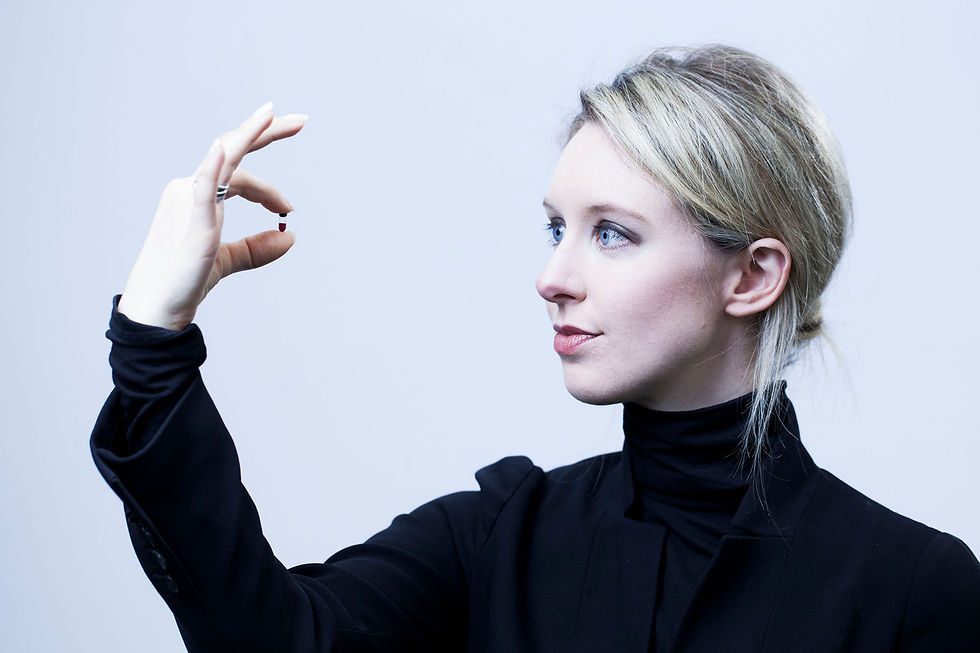The Rise and Fall of Theranos
- Carla Paz
- Feb 14, 2022
- 4 min read
Carla Paz

On January 4th, 2022, Theranos CEO Elizabeth Holmes was found guilty of “conspiracy to commit fraud against investors and three charges of wire fraud.” She was found not guilty for four of the charges against her. As Theranos’ $9 billion empire fell, Elizabeth Holmes became infamous to the public for her failed blood-testing machine.
The machine, called the Edison, was supposed to revolutionize the medical industry. Theranos had many famous politicians on its board of directors, such as George P. Shultz and Henry Kissinger, making Theranos’ fall from grace even more polarizing. As the public learns more about this case, many question how Elizabeth Holmes was able to pull all of this off without the general public realizing.
Elizabeth Holmes, nineteen at the time, founded Theranos after dropping out of Stanford University in 2004. During her time at Stanford, she came up with an idea to perform blood testing with only a prick on the finger instead of the usual vial. With these few drops of blood, her machine—the Edison—would be able to detect conditions such as HIV, diabetes, and cancer. Holmes’ idea stemmed from her and her family’s fear of needles. She once said in an article: “I really believe that if we were from a foreign planet and we were sitting here and said, ‘O.K., let’s brainstorm on torture experiments,’ the concept of sticking a needle into someone and sucking blood out slowly, while the person watches, probably qualifies.” Holmes told her Stanford professor, Channing Robertson, about her idea. Later on, he joined the company as part of the board of directors. During the company’s first few years, they kept a low profile. During this time, Ramesh “Sunny” Balwani joined Theranos as chief operating officer (COO). Shortly after, Balwani became romantically involved with Holmes. By 2009, Theranos had already raised $45 million by selling securities. In 2013, Theranos went public, added former CEO of Wells Fargo Richard Kovacevich, and military commander Gen. James Mattis. A deal with Walgreens was formed for the Edison. In 2014, Theranos was valued at $9 billion, and Elizabeth Holmes was profiled by many well-known newspapers, such as The New Yorker.
To the public and investors, Theranos and Elizabeth Holmes were trailblazers in the medical industry. Behind the scenes, however, this was not the case. Scientists at Theranos were doing everything that they could to make the Edison work. A scientist named Ian Gibbons was the chief scientist at Theranos. When he joined, he immediately noticed problems with the technology. His wife, Rochell Gibbons, explains, “He started talking to me about all these investments, all the money that the company is bringing in. And he told me that he couldn't imagine why people were giving the company any money because there was no invention, there was nothing there."
When Gibbons told Channing Robertson about his concerns regarding the Edison, Elizabeth Holmes fired him. A few hours later, he was re-hired but demoted. The stress from working at Theranos caused Gibbons to become depressed, and he started to drink heavily. A few days before a court deposition where Gibbons was to prove that the technology Theranos was developing worked, Gibbons committed suicide. Gibbons feared being fired if he told the truth about the Edison. Rochelle Gibbons never heard back from Holmes when she notified her about Gibbon’s passing. The only thing Theranos told her was to give back any company property. In 2015, The Wall Street Journal published an article exposing Theranos’ blood testing technology. The article featured information from a whistleblower, later revealed as George Shultz’s grandson, Tyler Shultz. As soon as he joined Theranos, he realized that the blood testing technology did not work. "It was clear that there was an open secret within Theranos that this technology simply didn't exist," said Shultz. Tyler Shultz contacted John Carreyrou, a reporter at The Wall Street Journal, and state regulators in New York—exposing the Edison.
In 2021, Elizabeth Holmes’ trial started. During the trial, jurors heard from almost thirty witnesses brought by prosecutors to show the web of lies spun by Holmes. When Elizabeth Holmes took the witness stand, she accused her ex-boyfriend “Sunny” Balwani of abuse, saying he had “clouded her judgment.” She expressed remorse on the stand, apologizing and wishing she could have done better. Holmes then blamed lab directors and Balwani for the technology not working. She was convicted of three counts of wire fraud and conspiracy to commit wire fraud. For four other charges, she was found not guilty. Holmes has not been sentenced yet, but the maximum sentence is twenty years in prison.
It is important to note that Holmes’ connections—even before her company was renowned—are part of the reason she was able to get away with this. Her father was vice president of Enron, an energy company, and her mother was a congressional aide. Her parents’ connections and wealth are part of the reason why she was able to get funding for Theranos. If it weren’t for the $100,000 Elizabeth Holmes was gifted by her parents, Theranos would have never gotten off the ground. Holmes’ connections with powerful capitalists such as Timothy Draper were formed through her parents. If she didn’t already have the connections and money, she would have never gotten through to all these influential people.
The lies Elizabeth Holmes told hurt many and would have continued to if she had not been stopped. Thousands would have received false blood tests. Many would have been diagnosed with diseases they don’t have, or diseases would have never been detected. Elizabeth Holmes has barely taken accountability for what she has done. It is as if she doesn’t realize or care about how disastrous this was and could have been for thousands.
Sources:
Comments